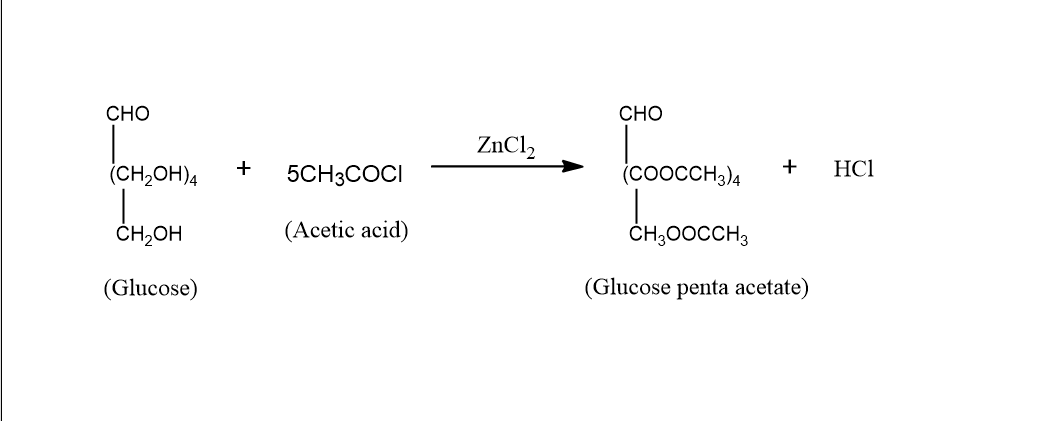
Glucose on reaction with acetic acid gives glucose Penta acetate. What does it suggest about the structure of glucose?
Answer
389.1k+ views
Hint: Recall the reaction of glucose with acetic anhydride. It is the same reaction. Glucose with acetic anhydride also gives glucose Penta acetate. The reaction is known as the acetylation of glucose. The glucose Penta acetate is a very stable compound.
Complete Step By Step Answer:
The above question states that “Glucose on reaction with acetic acid gives glucose Penta acetate”. Now we will have to look into the reaction of glucose with Penta acetate to solve the problem and to find out the structure of glucose.
When glucose reacts with acetic acid it gives Penta acetate. The reaction takes place under the presence of Zinc chloride. The reaction is as follows:

In the above reaction, we can see that the glucose structure has
This glucose Penta acetate is the beta-D form of glucose. It is insoluble in water. It is soluble in chloroform and methanol. Its chemical stability is very high and has a long shelf life.
Note:
The above reaction is similar to that of the reaction of glucose with acetic anhydride. This is also produced by glucose Penta acetate and confirms the presence of
Complete Step By Step Answer:
The above question states that “Glucose on reaction with acetic acid gives glucose Penta acetate”. Now we will have to look into the reaction of glucose with Penta acetate to solve the problem and to find out the structure of glucose.
When glucose reacts with acetic acid it gives Penta acetate. The reaction takes place under the presence of Zinc chloride. The reaction is as follows:

In the above reaction, we can see that the glucose structure has
This glucose Penta acetate is the beta-D form of glucose. It is insoluble in water. It is soluble in chloroform and methanol. Its chemical stability is very high and has a long shelf life.
Note:
The above reaction is similar to that of the reaction of glucose with acetic anhydride. This is also produced by glucose Penta acetate and confirms the presence of
Recently Updated Pages
Master Class 9 General Knowledge: Engaging Questions & Answers for Success

Master Class 9 English: Engaging Questions & Answers for Success

Master Class 9 Science: Engaging Questions & Answers for Success

Master Class 9 Social Science: Engaging Questions & Answers for Success

Master Class 9 Maths: Engaging Questions & Answers for Success

Class 9 Question and Answer - Your Ultimate Solutions Guide

Trending doubts
Give 10 examples of unisexual and bisexual flowers

Draw a labelled sketch of the human eye class 12 physics CBSE

Differentiate between homogeneous and heterogeneous class 12 chemistry CBSE

Differentiate between insitu conservation and exsitu class 12 biology CBSE

What are the major means of transport Explain each class 12 social science CBSE

Why is the cell called the structural and functional class 12 biology CBSE




